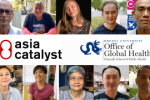By Sara L.M. Davis
In his recent New York Times op-ed, Paul Farmer calls for increased funding for
the Global Fund to Fight AIDS, Tuberculosis and Malaria. He’s right, but to
really put muscle into the fight against HIV/AIDS, the Global Fund also needs
to change its top-down approach to funding, given the reality that HIV/AIDS
specifically targets the most marginalized people in any society.
As Farmer rightly points out, the Global Fund has dramatically
increased funding to get antiretroviral medicines to millions of people–an
important victory that has saved many lives. It did this by leveraging
multilateral funding to strengthen health ministries and medical services for
people living with HIV/AIDS, and insisted that civil society be part of the
process of applying for and managing grants. Yet civil society continues to be
marginalized in many countries where the idea of a “nongovernmental
organization” is still new and threatening to an authoritarian government.
Developing a comprehensive national healthcare response to
HIV/AIDS requires infrastructure. Thus a good portion of the GF’s grants have
focused on building medical systems, and rightly so. In the Global Fund model,
countries create “country
coordinating mechanisms“, or CCMs, “multi-stakeholder” groups that bring
together representatives from industry, government, academe, and civil society,
as well as people living with the diseases. These CCMs submit proposals that
reflect their collective plan for HIV/AIDS prevention and treatment. They are
responsible for selecting a primary recipient, who handles the national grant
and awards sub-grants to others. It’s a sensible, top-down hierarchical
approach to managing a national epidemic.
But HIV/AIDS challenges that logic. HIV has tended to affect
people who are most vulnerable to sexual and blood-borne transmission: sex
workers, drug users, sexual minorities–populations who are also socially and
economically marginalized–often, criminalized. While the flows of funds largely
follow the channels of power, the trajectories of HIV transmission follow the
channels of marginalization. This is where CCMs run into trouble.
In practice, despite the “it’s a small world after all,
we’re all in it together, multi-stakeholder” vision, CCMs tend to be dominated
by government representatives. As an ITPC report found,
NGO and PLWHA representatives are often outnumbered by government officials and
their allies, and are often just not taken seriously in the decision-making
process. In addition, NGO and PLWHA representatives may also be simultaneously
trying to run their own under-resourced NGOs and respond to the needs of a
vocal and critical community, so their focus is divided. They also have to
navigate through reams of reports, policies and other paperwork for the Global
Fund, usually in English, in which the NGO or PLWHA representative may or may
not be fluent. And there is no system for making sure that civil society
representatives actually consult with, or report back to, the people they are
supposed to represent. In some cases, CCMs have become little more than rubber-stamps
for government proposals.
But the problems go beyond the makeup of the CCM–especially
in authoritarian or very hierarchical societies. In these countries, power hews
closely to government centers and to those with good government relationships.
But drug users, sex workers, and others on the margins of society don’t have
those relationships.
In fact, when we travel to cities and towns in Asia to work
with grassroots HIV/AIDS NGOs, it is often striking how their geographical
marginalization mirrors their political marginalization.
I still remember one of the first HIV/AIDS NGOs I visited in
Hong Kong in 2002. Here, in one of the wealthiest and most socially progressive
cities in Asia, the NGO office was hidden in the back of an old airport
terminal, behind a retail automobile showroom and a bowling alley, under a sign
labeled, “Activity Center” (活动中心)。 Even in this remote location,
the NGO staff said, a sign that more explicitly described their HIV/AIDS work
would attract outrage, fear and retaliation from their neighbors.
The nonprofits we work with are frequently hidden in this
way. We’ve held workshops for sex workers in a car wash, trainings for drug
users in a back-alley storefront, and seminars for gay men in an unmarked
residential apartment building. We’ve held workshops in the upstairs rooms of
churches on a weekday afternoon, when the front gate was locked and the church
apparently closed. The communities our local partners serve skulk into these
facilities, with tense casualness, while looking over their shoulders to check
if they’ve been seen.
Their economic background, educational background, and
social background–combined with their connection to one of the most stigmatized
epidemics in human history–all mark directors of grassroots NGOs as outside of
the halls of power. For all these reasons, they are less likely to be able to
leverage the connections needed to get access to funds that flow down from the
top of a hierarchy. Or as one NGO staff person put it to me once, “At every
level of the system, someone takes a cut of our grant. By the time it gets to
us, we’re lucky to get a third of what we were promised.” One study
found that only 19 percent of Global Fund grants go to NGOs.
CCMs are an illogical way to fund groups that are led by and
that serve people on the margins of society. The challenge posed by HIV/AIDS
demands that we think of new ways to get funding to programs developed by and
led by those communities. This could mean direct funding for national networks
that work with specific communities such as sex workers, drug users, PLWHA, and
MSM (though even this wouldn’t address the need for HIV/AIDS programming among
communities so politically marginalized or restricted that they can’t even
organize NGOs or networks–for instance, certain indigenous groups, ethnic
groups, migrants and refugees).
Another approach might be to grant to coalitions of diverse
stakeholders (NGOs, government, academics, private businesses) that work on
specific problems. This would promote multi-sectoral cooperation that is
targeted and pragmatic, bringing together people with shared priorities to work
on programs.
The solution the Global Fund has come up with, in China, is
to terminate its support. This month, the Global Fund announced that due to
shortfalls, it will phase out funding for Chinese HIV/AIDS projects by 2014.
The Global Fund’s argument is that China is a middle-income country, which
should be able to fund the AIDS response directly.
This may be true–but it doesn’t make it any more likely that
China’s grassroots NGOs will get that funding. The Global Fund, and other
international donors, should develop new mechanisms to get the funds to groups
on the margins, not the center.




